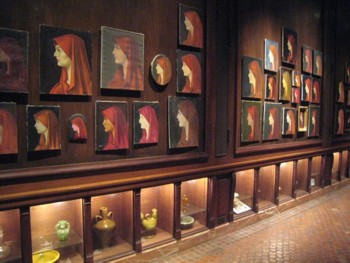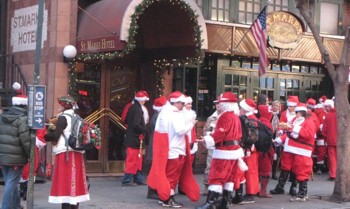main: January 2008 Archives

Francis Alÿs, Fabiola (detail) .
Divorce in Art
First multiple Santas in the last Artopia posting and now multiple Fabiolas!
But multiplicity wasn't invented yesterday, nor by Andy Warhol when he multiplied his Campbell's soup cans, Marilyns, and Jackies. Think instead of the myriad figures in a Tibetan tanka. Or those dying genres, photo-booth samples and sheets of postage stamps. Admittedly the photo-booth samples are usually images of many different grimacing customers or one-off strips picturing singles or couples in a variety of poses. Andy Warhol based some of his silk-screened portraits on photo-booth pictures (art dealer Holly Solomon, for one), but I am not sure any booths survive.
In terms of Warhol, it was not new to make the same painting over and over. In some sense, Ad Reinhardt was already doing that with his all-black paintings, and almost any artist committed to exploiting a signature image could be so accused. What Warhol did that was different was to lay out silkscreened variants of a single image as one artwork. Some might say that the subject did not matter, it was the repetition that counted. Dumb repetition was the real subject.
Belgian-born Francis Alÿs, presently living in Mexico, until now has been most noted for his Dia-sponsored Thief screensaver (1999)...

and for his 2002 MoMA parade from Manhattan to the temporary MoMA-QNS in Queens. His Modern Procession involved 200 participants carrying art replicas and the actual Kiki Smith across the Queensboro bridge...

Now we are privy to his collection of nearly 300 images of St. Fabiola. Most of the images are paintings, but some are needlepoint and others are emblazoned on cheap jewelry. Alÿs's Fabiolas are now on display at the Hispanic Society of America (Broadway between West 155th and 156th streets, to April 6. FREE).
"Fabiola" is a collaboration between the Hispanic Society and the Dia Art Foundation. Is it art? Lynne Cooke, Dia's curator, wrote the informative handout, but curiously avoids the issue. In Artopia we are not timid. This indeed is art. It is found-art multiplied.
Obviously, the Dia Art Foundation is eager to regain a foothold in New York City, searching for renewed visibility and needing a positive spin after the decampment of director Michael Govan for the Los Angeles County Museum of Art and the subsequent walk-out and divorcement of Dia Beacon funder Leonard Riggio (founder and CEO of Barnes & Noble).
Fabiola was a 4th-century Christian saint, a protector of nurses and abused wives. A wealthy Roman, according to the oddly condensed syntax of the Catholic-Forum's Index of Saints, she was ...
Divorced from her first marriage after being abused by her adulterous husband. Widowed in second marriage. Friend of Saint Jerome, Saint Paul, and Saint Pammachius. Founded the first hospital in the west. Built a hospice in Porto for the area poor and sick pilgrims. After doing penance for her divorce, she re-entered communion with the church by dispensation of Pope Saint Siricus. Wanted to live as a hermit in Jerusalem, but never managed it.
So why isn't she also the patron saint of wealthy matrons or of the divorced? Or, as we shall see, of lost paintings? Or of would-be but failed hermits? And I love the last phrase: "Never managed it." Why not? Would she have had to give up her scarlet hood?
Centuries later her reputation was fueled by the hugely popular The Church of the Catacombs (1854), by a certain Cardinal Wiseman. In turn, this potboiler led to the painting of the now lost, icon-generating Fabiola by the little-known French academic Jean-Jacques Henner. Judging by the copies of copies this fantasy depiction generated, Henner's St. Fabiola showed her in profile, wearing a scarlet hood.
Alÿs has been collecting these popular replicas of replicas for a number of years. He had thought of flea-marketing for da Vinci's Last Supper, but there were simply many more Fabiolas.
And here they are: nearly 300 Fabiolas at, of all places, the quaint, wood-paneled North Building Galleries of the Hispanic Society, looking ... well, fabulous.
So who is this Alÿs? Although he tends to get others to do his work for him, his output is refreshingly sparse. He avoids a signature style or even format. He has not yet been packaged.
In 1997, he pushed a block of ice through the streets of Mexico City.

Alÿs, The Paradox of Praxis .
For When Faith Moves Mountains (2002), he attempted to move a sand dune in Peru with the aid of 500 volunteers....

What connects these works to Thief? And the Modern Procession?
We await a larger sampling of Alÿs's art. "Francis Alÿs: Politics of Rehearsal" is now at the Hammer Museum in Los Angeles (to Feb. 10).
In the meantime, the Fabiola depictions range from plausible to draw-me-matchbook dull and coloring-book crude. It is the multiplicity that charms. Although most of the profiles face viewer-left, some look stage left as if we are seeing Fabiola in a mirror.
Taking in these Fabiolas is a peculiar way of seeing the original. Imagine if we knew Goya's 1797 Portrait of the Duchess of Alba (The Black Duchess) only through amateur copies or cheap photographs of less-than-famous actresses dressed as majas.
Fortunately, right there on Audubon Terrace in the Hispanic Society's South Building across the way is the real Goya maja, arguably the signature artwork of this undeservedly obscure institution. I myself years ago had made a pilgrimage to Washington Heights to see the Duchess. Or was it to see the El Grecos?

Divorce on Parade
Many art lovers, whether tourists or local repeat visitors, go to museums for signature artworks. If art is merely loaned out piecemeal here and there -- as patron Eli Broad has now decided will be the case with his 2000-item collection, most of which many assumed would go to LACMA -- it is unmoored, divorced from any consistent institutional context and will not really belong to the public.
You go to MoMA to see Manet's Water Lilies or a particular Mondrian. Or you need your Picasso fix. You go to the Philadelphia Museum of Art to see The Bride Stripped Bare By Bachelors, Even. Or maybe not. Not everyone "owns" the same paintings, but there are certain artworks that are emblems of certain institutions.
So where's the art? Who's got the art? Here and there and everywhere, or in storage. Or constantly on the road, which can't be good for the art. Foundations are quirky entities.
In terms of the Broad "scandal," as others have pointed out, artists need to beware of the "private foundation Catch-22." Sales are sales, of course, but a foundation can dump artworks on the market with impunity. Museums at least have a stake in not exposing their mistakes or their need for ready cash in a hot market. Most museums have or should have clear guidelines for their deaccession committees.
I am not saying that Broad will dump artworks; he doesn't need to. But there is always the next $20 million art bargain just around the corner, and other retired moguls have been known to go for the deal they cannot afford to pass up. Buying and selling is a high.
If Broad really believes in art, he should really start his own museum and make it free to the public. And endow it well enough so that it stays free. Where are the Andrew Carnegies of art? Andrew Carnegie set up free public libraries all across America.
Although the Broad Museum of Contemporary Art at LACMA is set to open thanks to Broad's $60 million, galleries are naming opportunities for additional donors. For a mere $10 million, Marc and Jane Nathanson will get a gallery named after them. Further happy news: It was just announced that Zaha Hadid will be the architect for the forthcoming Eli and Edythe Broad Art Museum at the University of Michigan. Broad's $26 million covers a little more than half the cost.

Can Art Be Divorced From $$$?
I am usually divorced from these art-world topics, but they keep intruding like unwanted auction news. It used to be that show business was everybody's business. Now art is.
And while I am at it, I am also fed up with all the praise being heaped upon the now retiring Philippe de Montebello. I suspect his rise to power and his 30-year tenure as director at the Metropolitan Museum of Art has something to do with the hatred accrued by predecessor Thomas Hoving. De Montebello has managed to add some exhibition spaces to the museum and straightened out others. He did the basics: kept the institution from collapse, lawsuits, and outright scandals. He had the good sense to return some stolen artworks to Italy.
But I would like to remind all Artopians of the following: (1) He has never really supported modern and contemporary art. (2) As the Met's CEO, he has been responsible for annual operating deficits that have recently run as high as $3 million. (3) He oversaw and actively defended the constantly increasing admission price, which is now $20. This tithe is "voluntary," but it is not readily perceived as such by most visitors.
I did a little research:
Until 1941, the Met charged admission only one or two days a week. In 1940, the admission was 25 cents on Mondays and Fridays. From 1941 to 1979 it was totally free. Those were the glory days, the democratic days.
In 1970, under Hoving, a regular admission of $1.50 was instituted.
I remember how angry I was when the Met started charging admission. It was like having to pay to get into your own living room. I had very little money, but was hungry for art. I suppose I could have paid $1.50 by skipping lunch, but on principle I never shelled out more than a Rockefeller dime, which was the old man's customary sign of largesse.
Five years later, under de Montebello, admission was increased to $1.75. It was $6 in 1993; in 1999 it went from $8 to $10. Oh, yes, said Philippe back then, they had lost some money once promised by the Reader's Digest heir. Oh, the fickle rich. And then in 2006, admission moved from $15 to $20.
The Whitney and the Brooklyn museums were once free too. As for MoMA, we never expected it to be free. The rumor was that when old man Rockefeller was asked by his daughter-in-law Abby Aldrich if they should charge admission to her new museum, he answered that no one would appreciate the art if they didn't.
If we pay $20 to look at art, is it better than the art we can see for free? And if so, would a $40 ticket make the art look twice as good?
I think free art looks better because you have more time to look at it. You don't have to rush through to get your money's worth. You know, if it's two o'clock, I must be in the Greek and Roman Galleries. If it's three, I must have already covered the Renaissance.
Therefore:
If I am elected mayor of New York on the Pro-Art Barnett Newman Party ticket, the Metropolitan Museum of Art, which is housed in a city-owned museum and receives free heating and electricity, will be free to all, with no challenges like the tiny Pay What You Want But Pay Something sign. The hard-working citizens of New York and even the tourists on their Euro spree already pay their share by way of the city sales tax.

For an Automatic Artopia Alert for each new posting contact: perreault@aol.com

Santa Babies
One Saturday before Christmas after my merry rounds uptown, searching here and there in galleries for art rather than looking at art, I was on my way back to my East Village lair, when....
I was treated to the spectacle of multiple Santas. They were hanging out on historic St. Mark's Place. This uncomely but vital boulevard, once the home of the Dom and Andy Warhol's Plastic Floating Inevitable, is now a battleground between bustling tattoo parlors (Whatever Tattoo, Dots NY, et al.) and serenely empty, mostly Asian, supermodern fast-food franchises, looking like beta versions of concepts ready to take over the post-dining world: Good Dog, Very Berry, T Kettle, Pinkberry. BAM Automat is the exception. It's a glistening stand-up with little coin-liberated windows offering slider-size burgers, corn dogs, macaroni and cheese, fried Spam, and the $2 grilled cheese sandwiches that are much too much my favorite grab.
The largest gaggle of Santas, however, was in front of a bar near Kim's, my essential video provider. Santas not outside the saloon smoking were inside hoisting tankards of beer or throwing back the potent contents of shot glasses. It obviously takes a great deal of liquid reinforcement to parade around in a Santa suit in broad daylight. My digital at hand, I snapped away. I don't know if this was before or after the Santas were instructed by text-messaging to dance their brains out further east in Tompkins Square, where once in the Roaring '60s there was a Be-In.
I had experienced my first SantaCon, which is short for Santa Conference, the performance form that generated Flash Mobs. I have been so enthralled by the official art world -- the scandals, the auctions, the cash piles and the career crashes -- that I had remained blissfully unaware of SantaCons, or what I would prefer to call Santa Swarms. They are of suspicious origin, but apparently date back to 1994 and are arguably the precedents for Flash Mobs, which are even more suspect.
So once I found SantaConNYC on the internet I immediately hatched a plan to join up next year and, clad in Santa drag, as an Artopia spy, get the inside dope. Unfortunately, the august New York Times, ever ready to destroy new art by labeling it a trend, scooped me with "Naughty Santa Reveals All." Well, not quite all. Is it really true that most SantaCon Santas have not met before? Has romance among Santas bloomed? Do you get to keep your Santa togs? Are there repeat offenders? Do any of the Santas know they are making art? And since Santa Conferences have been going on for at least 13 years, does Santa Swarming run in families? I also wonder if Kris Kringles participate in other Flash Mobs?
Once I started Googling, I couldn't stop.
On the SantaCon website I count 65 official SantaCons this year: not only in New York and San Francisco, but also Asheville and Philadelphia. Not only in London, Munich, and Paris, but also Bangkok, Mumbai, and Phnom Penh.
If you still not have had your fill of Bad Santas, for more images and the full N.Y.C. itinerary go to this site.
There are now Zombie Mobs every year. This Flash Mob variant had its origin in San Francisco, that city known for its seriousness and good taste.
And Pillow Fight Swarms worldwide.

Nomenclature
The term Flash Mob has been around since 2003. That indisputable source of all factoids, Wikipedia, credits Bill Wasik (a senior editor of Harper's Magazine!) with launching the first Flash Mob (according to Wasik himself), which seems to have involved getting hundreds of young men and women to go through the motions of purchasing an expensive rug at Macy's.
Flash Mobs happen in a flash. They are inexplicable, so they are sometimes referred to as Inexplicable Mobs.
Not only are they public, anonymous and quick, they have to be senseless. Participants are instructed by e-mail, cell phones, or text-messaging.
What I dislike about the terms is not the "Flash" or the "Inexplicable," but the "Mob." It all sounds criminal and/or mindless, which may have been Wasik's intention, since he seems to have wanted to make fun of disaffiliated youth or D. Y.'s on a spree.
Since most Flash Mob organizers insist on appropriate respect for persons and property, which is a good way to keep out of jail, I prefer the less negative Swarm and Swarming. But Mob, I admit, does have a certain Jimmy Cagney frisson.
Although they are mostly apolitical and do not involve igniting stuffed manikins, Flash Mobs may have a darker, historical origin: the Anglo-Saxon tradition of effigy-burning while dressed up in costumes, once adopted by unfairly treated tinsmiths, tailors, and the like, in pre-Draft Riot, pre-Santa New York City. I have been reading Sean Wilentz's Chants Democratic: New York City and the Rise of the American Working Class (1788-1859) and found this toss-off reference to antebellum protest.
Nevertheless, no matter what the deeper genesis or whatever the nomenclature, SantaCon -- at least in Artopia -- is the origin of all Flash Mobs and Swarms, and not some editor of Harper's. It is about time we gave the Santas their due.

Drop Till You Shop: It's the Idea That Counts.
Another Christmas-appropriate art form is Shopdropping.
It is, as the clever name implies, the opposite of shoplifting. Handmade merchandise, replicas, and altered products are inserted next to the real things in stores to surprise, politicize and/or aestheticize the unwary shopper (or checkout clerk).
There has already been an exhibition of Shopdropping at the Pond Gallery in San Francisco in 2005.
Zoe Sheehan Saldana, upon the occasion of her show at real Art Ways in Hartford, had her 10 minutes of fame, courtesy of the N.Y. Times and the Philadelphia Inquirer. She made and inserted exact copies of Wal-Mart clothes, later exhibiting the originals along with photos of her facsimiles.

But Is It Art?
Are Swarms or Flash Mobs art? Well, they certainly allow the free play of signifiers and thus participation/co-creation by interpretation -- both sure signs of modernism/postmodernism. Art historical anchors are Actions, Events, Happenings, Performances, Kusama's nude street extravaganzas, or the more individualistic and elitist Street Works of 1969. However, a few cues are missing. Authorial attribution is scant. Signs of artistic intention, such as direct address of art media and art audiences, are virtually non-existent. So far there is nothing for sale. And luckily there has been no institutional ratification.
At this point, my feeling is that Swarms are closer to celebrations, pageants, and parades, than to signed art, but they are art in the largest, if not the highest, sense.
Well, I take that back. Why not highest? Like Mardi Gras floats, Halloween parades, Christmas lights, and roadside memorials, they are art of, by and for the people -- in this case mostly young and cyber-savvy, not all of them male.
Little of this applies to Shopdropping, which is usually not collective. Although Shopdropping can be aligned to Appropriation Art, and like Swarms is seriously interventionist, the shopdropper is looking over his or her shoulder at the art world. I do not mean this as a condemnation, but as a description. Normal paradoxes therefore come into play and irony has its day.
When Flash Mobs swarm into stores and malls, they are not unrelated to Shopdropping. Context is all. An example would be the Shirtless Flash Mob, perpetuated by Charlie Todd's ImprovEverywhere. On October 13, at Abercrombie & Fitch, Fifth Avenue, over 100 young men took off their shirts. Here we have an "author." And we certainly have a critique of advertising and shopping.
Abercrombie is noted for its successful ads and photo-décor of hairless, bare-chested, gym-boys with perfect pecs. In the web-photos, the contrast between real guys and the homoerotic youths depicted in the Abercrombie campaign is telling. Unanswered, of course, is the question of why such depictions successfully sell clothes to young men of all persuasions. I guess for somewhat the same reasons that skinny fashion models sell clothes to women of all sizes. Who you REALLY are is not important, but who you want to be is what counts.
* * *

Shopdropping According to Jonathan Swift
Artists, I fear, have upon occasion Shopdropped their art into galleries and museums. Some are now wanted by the art police, some are in art jail, some are still getting away with it. I will not mention names.
In 1958, James Lee Byars (1932-97) debuted in New York City with a paperwork in an empty MoMA stairwell. Reportedly it only lasted a few hours and was approved by the highly respected curator, Dorothy Miller. Since it did not go through regulation channels and was unpublicized -- but most likely went unseen by the public -- is this an early example of Shopdropping?
And what do you with Giorgio de Chirico, who faked his own earlier work, "dropping" into the art market 18 backdated versions of his 1918 The Disquieting Muse? How do you handle a venerated abstractionist who delivered still-wet, freshened versions of his old paintings to his museum retrospective? Were these also just more sophisticated versions of Shopdropping?
Dots used to appear next to artworks. Red meant sold; half-a-red or a blue signified reserved. Now the truth can be told: some dots were fakes. This intervention -- whether perpetrated by the artists themselves, gallerists, or strangers -- must have gotten out of hand, because nowadays dots are nowhere to be seen. Maybe this is an effort to give art shops the aura once attached to museums.
I think the red dot system should be embraced again, but by art museums. Because exhibitions are expensive and government funding is scarce, most museums contract to keep a percentage of sales of artworks. In order to help museums with their bottom lines, I also suggest that price lists be readily available, just as New York State law requires of for-profit galleries.
FOR AN AUTOMATIC ARTOPIA ALERT WHEN NEW TEXTS ARE POSTED PLEASE CONTACT: perreault@aol.com
AJ Ads
AJ Blogs
AJBlogCentral | rssculture
Terry Teachout on the arts in New York City
Andrew Taylor on the business of arts & culture
rock culture approximately
Laura Collins-Hughes on arts, culture and coverage
Richard Kessler on arts education
Douglas McLennan's blog
Dalouge Smith advocates for the Arts
Art from the American Outback
For immediate release: the arts are marketable
No genre is the new genre
David Jays on theatre and dance
Paul Levy measures the Angles
Judith H. Dobrzynski on Culture
John Rockwell on the arts
Jan Herman - arts, media & culture with 'tude
dance
Apollinaire Scherr talks about dance
Tobi Tobias on dance et al...
jazz
Howard Mandel's freelance Urban Improvisation
Focus on New Orleans. Jazz and Other Sounds
Doug Ramsey on Jazz and other matters...
media
Jeff Weinstein's Cultural Mixology
Martha Bayles on Film...
classical music
Fresh ideas on building arts communities
Greg Sandow performs a book-in-progress
Exploring Orchestras w/ Henry Fogel
Harvey Sachs on music, and various digressions
Bruce Brubaker on all things Piano
Kyle Gann on music after the fact
Greg Sandow on the future of Classical Music
Norman Lebrecht on Shifting Sound Worlds
publishing
Jerome Weeks on Books
Scott McLemee on books, ideas & trash-culture ephemera
theatre
Wendy Rosenfield: covering drama, onstage and off
Chloe Veltman on how culture will save the world
visual
Public Art, Public Space
Regina Hackett takes her Art To Go
John Perreault's art diary
Lee Rosenbaum's Cultural Commentary
Tyler Green's modern & contemporary art blog
